YouTrack's New Design
We’re excited to introduce a revamped navigation experience designed to enhance usability and streamline how you interact with YouTrack. Here's what's available now:
The horizontal navigation has been replaced with a sleek, collapsible vertical side panel, giving you more screen space and a cleaner interface.
To make it easier to find your way around the application, we've implemented breadcrumb navigation in the header.
Our new project-centric navigation lets you focus on issues and articles related to a specific project, minimizing distractions from unrelated content.
We’ve unified our issue views from YouTrack Classic and YouTrack Lite into a single, consolidated layout, bringing you the best of both worlds.
We've made it even easier to search for issues by adding dynamic filters that suggest possible attributes and values as you type.
Together, these updates simplify your interactions, improve productivity, and make the application more user-friendly.
New Navigation
The switch from horizontal to vertical navigation improves usability and maximizes screen space. Previously, the horizontal navigation menu spanned across the top of the application, which meant that many features were hidden from view on smaller screens. By transitioning to a vertical side panel, we’ve created a cleaner and more organized interface.
The new main navigation runs along the side of the screen and is collapsible, giving you more control over your workspace. When fully expanded, it provides quick and easy access to key features. When collapsed, it reduces visual noise and frees up horizontal screen real estate, leaving more room to focus on your tasks.
We've also added a Create action to the main navigation, which lets you create an issue or article from any page in the application.
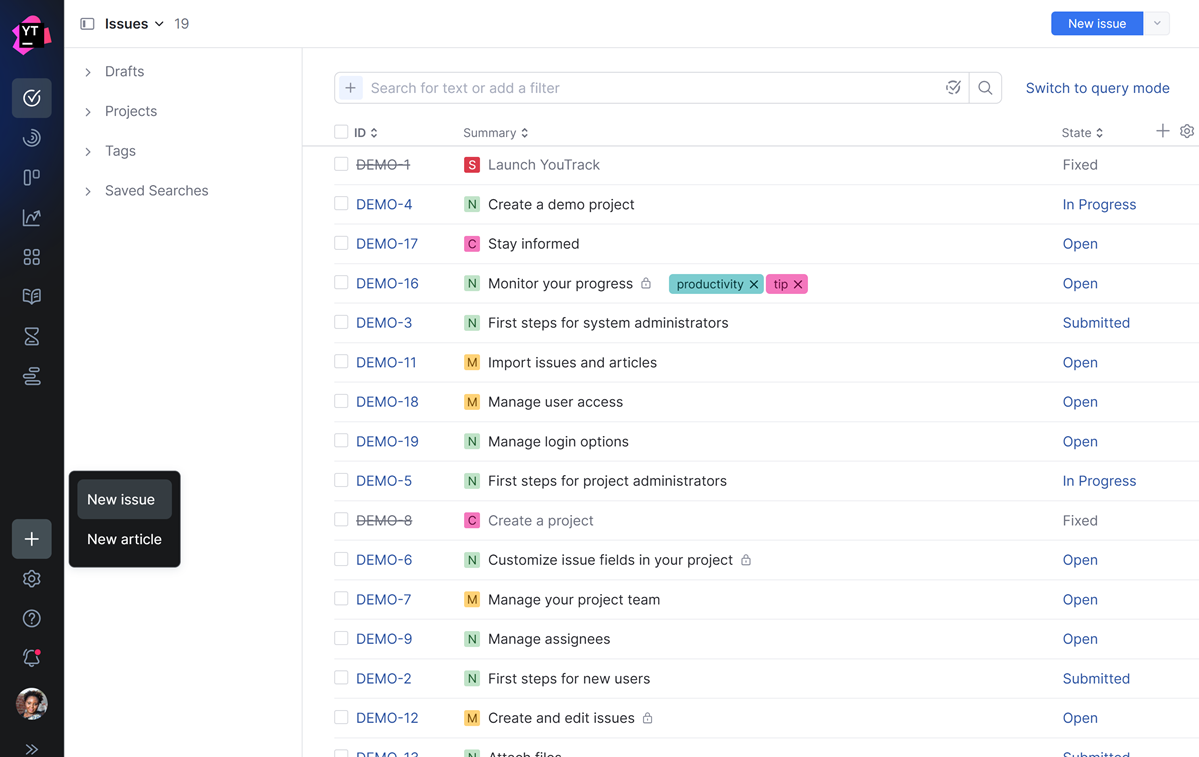
Breadcrumb Navigation
The addition of breadcrumb navigation is designed to help you stay oriented and easily navigate through different parts of YouTrack. Breadcrumbs provide a visual "trail" that shows your current location within the content hierarchy, making it simple to backtrack to a previous page or parent section without needing to re-navigate through menus. For example, if you’re viewing an issue within a specific project, the breadcrumb trail displays something like this:

For articles in the knowledge base, you see a similar pattern:

Each item in the breadcrumb trail is clickable, so you can jump directly to higher-level sections with a single click.
Breadcrumbs have also been added to other YouTrack pages, so you always know exactly where you are in the system.

Each page will typically have the following components in the header:
The name of the page in the system.
A selector that lets you choose what to display on the page.
A More menu that contains available options for the current view.
Buttons for primary and secondary actions.
Since most of the navigation-related controls have moved to the header, we were able to eliminate secondary navigation panels and create a consistent experience throughout the application.
Project-centric Navigation
One of the bonus features of the new breadcrumb navigation is the introduction of project-centric navigation. This helps you focus on a specific context for your work, minimizing distractions from unrelated content.
Project-centric navigation is accessible from the following entry points:
By clicking the Issues link in the breadcrumb navigation when viewing a single issue. This opens a list of issues in the project where the issue you were viewing was created and sets the project as the search context.

This means you can quickly browse through other issues in the project.
If you're working with a helpdesk project, you can experience something similar by clicking the Tickets link in the header of a helpdesk ticket.

This opens the list of tickets and sets the helpdesk project as the search context.
Use this feature to locate tickets for related cases or see how similar problems were resolved.
If you click the name of the project in the breadcrumb navigation, it opens the project overview page.
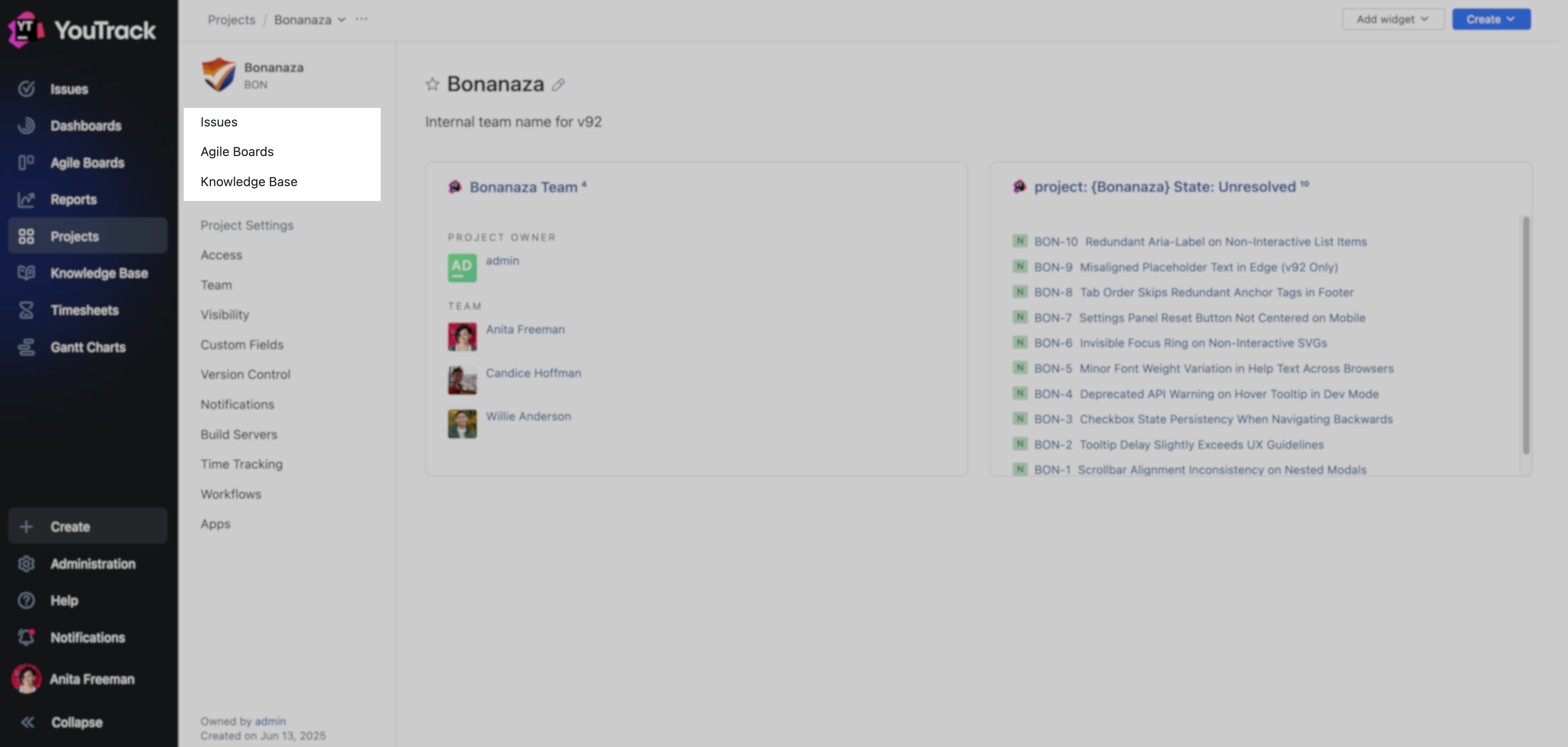
From here, use the Issues and Articles links to locate information stored in this project.
If you're viewing an article in the knowledge base, clicking the Knowledge Base link in the header opens a list of articles in the current project.

Click the project name in the header to return to the project overview.
Dynamic Filters
We’ve replaced the separate filtering implementations in YouTrack Lite and Classic with dynamic filters that make searching for issues faster and more intuitive. As you type, the new filters use natural language to suggest relevant attributes and values, helping you quickly narrow down your results without needing to remember complex search queries. Operators used to compare values that were only available when writing search queries can now be expressed using simple terms like equal or less than, on or after, and so on.

To learn more about this feature, see Simple Search.
Unified Issue Views
We've unified the issue views from YouTrack Classic and YouTrack Lite into a single, streamlined interface that combines the best aspects of both. This new unified view offers the power and flexibility you loved in YouTrack Classic with the simplicity and focus of YouTrack Lite, delivering a more consistent and efficient way to manage your tasks.
At the same time, we did our best to preserve the functionality supported for existing users, giving you the option to switch various features on and off based on your personal preference. If you liked the look and feel of YouTrack Lite but switched back to Classic because it was missing a feature that was essential to your workflow, you'll find it out of the box in the new UI.
When we migrated existing users to the latest version, we preconfigured their settings to preserve their previous user experience.
For users working with YouTrack Classic, the Layout option was set to List and the Preview option was set to Inline. Previous settings for Scale and Structure were left as they were before.
This combination of settings most closely resembles the look and feel of the Classic UI.
For users working with YouTrack Lite, the Layout option was set to Table. If you had enabled the Quick view setting, the Preview option was set to Sidebar. Otherwise, the Preview option was switched off.
This combination of settings most closely resembles the look and feel of the Lite UI.
To learn more about these configuration options, see Settings.
New Features
As part of this revamp, we were able to implement and improve several features used by everyone in YouTrack. These include:
Feature | Description |
|---|---|
Collapsible sidebar | We unified the sidebar that provides quick access to various issues.
To learn more about this feature, see Issue Sidebar. |
Dynamic filters | In previous versions, you had one option for filtering issue in YouTrack Classic and another filtering scheme in YouTrack Lite. For YouTrack 2025, we've replaced both approaches with a single, dynamic tool for filtering the list of issues.
To learn more about this feature, see Simple Search. |
Issue selection toolbar | One of the main advantages of YouTrack Classic over Lite was its ability to apply updates to a batch of issues. In the updated version, this feature is available to everyone. The new toolbar appears whenever you select one or more issues from the list. 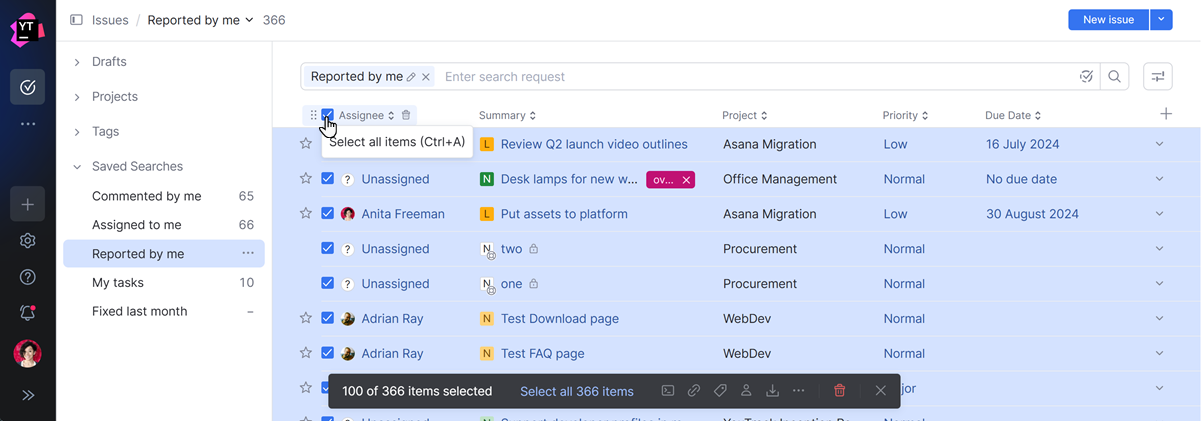 It supports a range of actions, including adding links, tags, files, custom actions, and more. To learn more about this feature, see Issue Toolbar. |
Keyboard shortcuts | By unifying issue views, we’ve introduced a single, consistent set of keyboard shortcuts for managing issues across YouTrack. This streamlined shortcut system makes navigation and issue management faster and more intuitive, eliminating the need to remember different commands for different interfaces. For a complete list of supported shortcuts, see Keyboard Shortcuts. |
Intuitive navigation | The interfaces for YouTrack Classic and YouTrack Lite included several elements designed to help navigate between individual issues and return to the issue list. The location of these elements varied by interface and behaved in different ways. Now that the main menu has migrated to the left side of the page, all the navigation controls can be found in the header.  This includes the newly implemented breadcrumb navigation, a persistent search box, and a counter for issues that match the current search query. The arrows to the left and right of the counter let you navigate to the previous or next issue in the list. |
Changes for YouTrack Classic Users
The unification of the two issue views means that users who previously worked with YouTrack Classic have access to features that were previously exclusive to YouTrack Lite. This includes:
Feature | Description |
|---|---|
Tabular layout | YouTrack Lite displayed the list of issues as a table. This would let users sort issues by visible attribute values without updating the search query.  This feature is now available as an option from the Settings panel, which means Classic users can switch over to this layout whenever they want. To learn more about this feature, see Layout. |
Recent issues and articles | Previously, the ability to access a list of recently viewed issues and articles was available exclusively in YouTrack Lite. The latest update makes this feature available to all users. 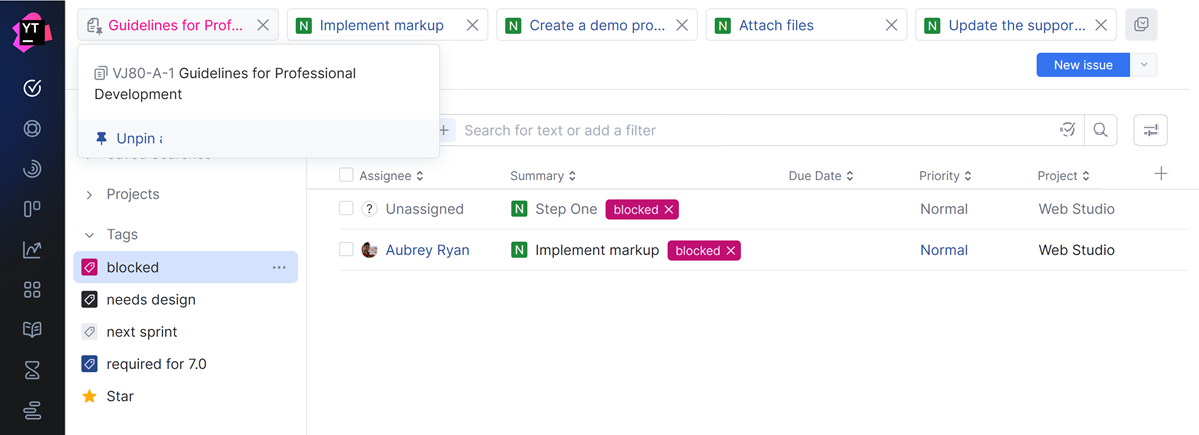 This feature is optional, which means you can switch it off if you don't need or want it. To learn more about this feature, see Recent Issues and Articles. |
Some features that were previously available in YouTrack Classic have been re-implemented in a slightly different way. This includes:
Feature | Description |
|---|---|
Search context | In YouTrack Classic, the option to limit the results to a specific set of issues was available by setting a search context in the search box. 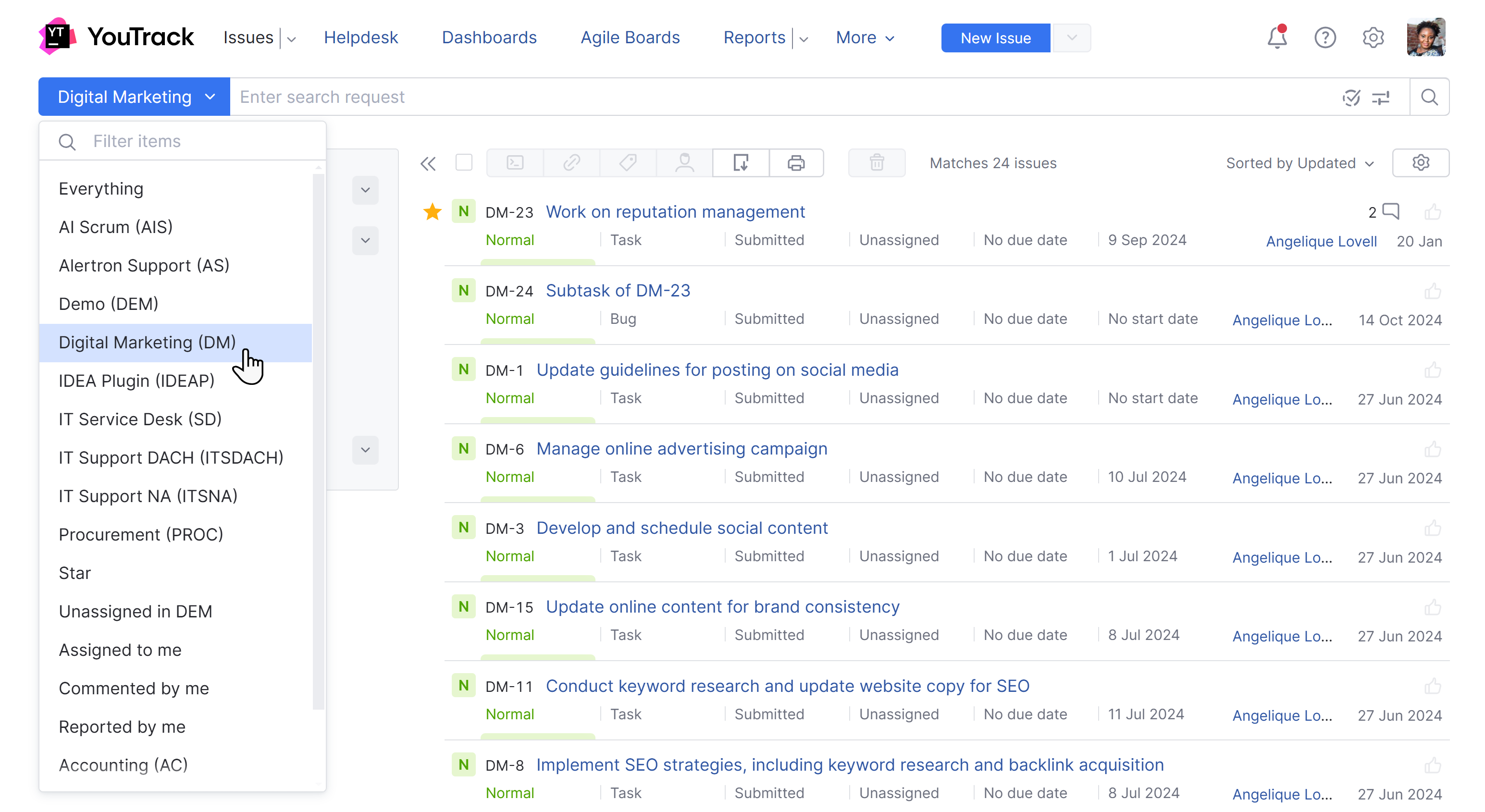 This feature is still supported, but its behavior has been modified. To set the search context in the new version, select a saved search, project, or tag from the sidebar.
To learn more about this feature, see Search Context. |
Streamlined creation and update for saved searches | In older YouTrack versions, you could create a new saved search by clicking the  In the new UI, the option to save a new search query is shown whenever you filter the list or enter a search request.  When you open a saved search and modify the search criteria, you can either save the changes as a new search or update the existing saved search.  |
Issue toolbar | The static toolbar at the top of the list has been replaced with a dynamic version. This toolbar is only visible when you select one or more issues in the list. |
Issue filters | The static filters below the search box have been replaced with dynamic filters that you can access directly in the search input. Even though you can no longer configure and work with a predefined set of filters, available filters are suggested automatically as you type. This means you can find exactly what you're looking for with fewer clicks. |
View mode | The issue toolbar in the Classic UI included a sliding control that let you switch between different levels of detail. Since this option isn't supported in table view, the control was moved to the Settings panel. These new settings let you switch between a variety of views and layouts without leaving the page. |
Changes for YouTrack Lite Users
Users previously working with YouTrack Lite have access to advanced features that were exclusively available in the Classic version of the interface. This includes:
Feature | Description |
|---|---|
Tree view | The ability to view the list of issues as a hierarchical tree was previously exclusive to YouTrack Classic. With this update, you have the option to switch between a flat list and tree view. 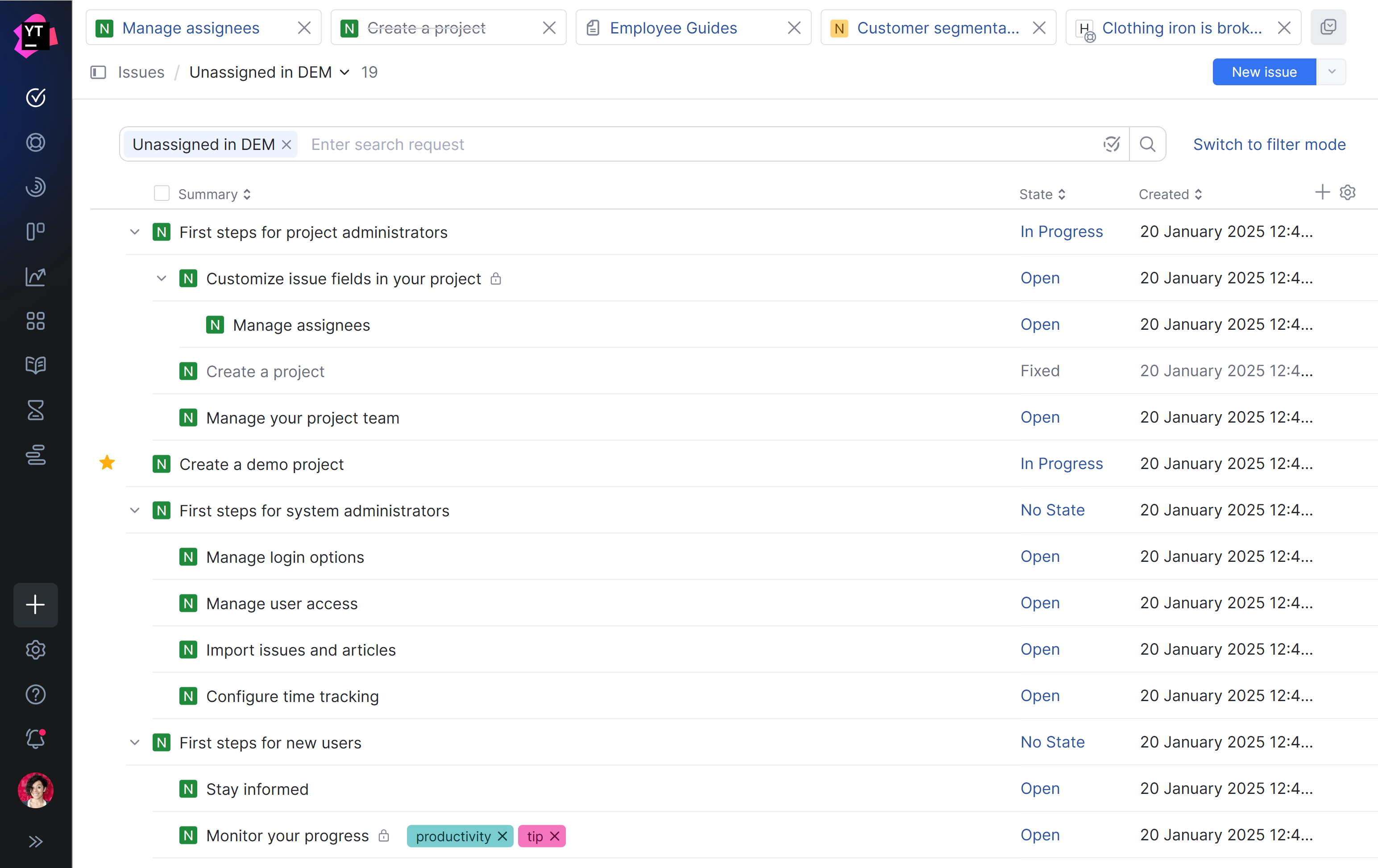 To learn more about this feature, see Structure. |
Manual sorting | This update lets everyone manually sort issues using simple drag-and-drop functionality. Reorganize your issue lists to reflect current priorities or personal preferences. 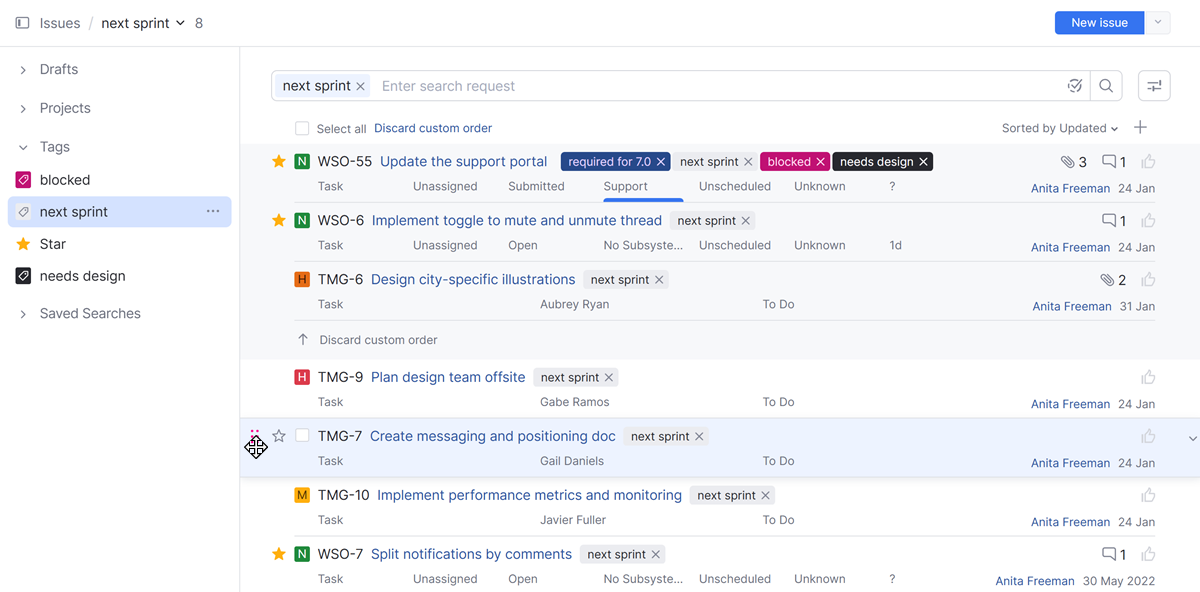 To learn more about this feature, see Reorder Issues Manually. |
Sorting by relevance | YouTrack Classic users had the option to sort search results by relevance. This option lets you see issues based on the number of times they contain matching keywords. With the latest update, this feature is available to anyone who works with issues with the Layout set to List.  |
View modes | The layout for issues in YouTrack Lite displayed a limited amount of information for each issue in the table. Now that everyone has the option to switch between a table and a list, users who were working with the Lite UI have access to an additional Scale setting. 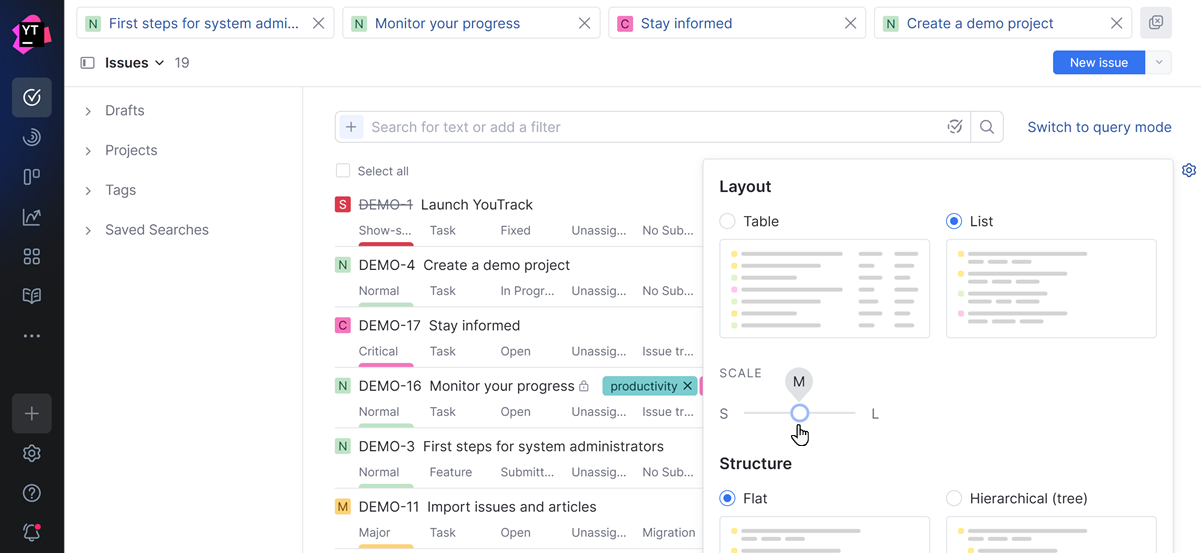 When working with the Layout set to List, use this option to manage the level of detail in the list. |
Batch updates | The unified list contains options to select one or more issues in the list. This means you can perform batch updates on a list of issues using the Apply Command dialog. 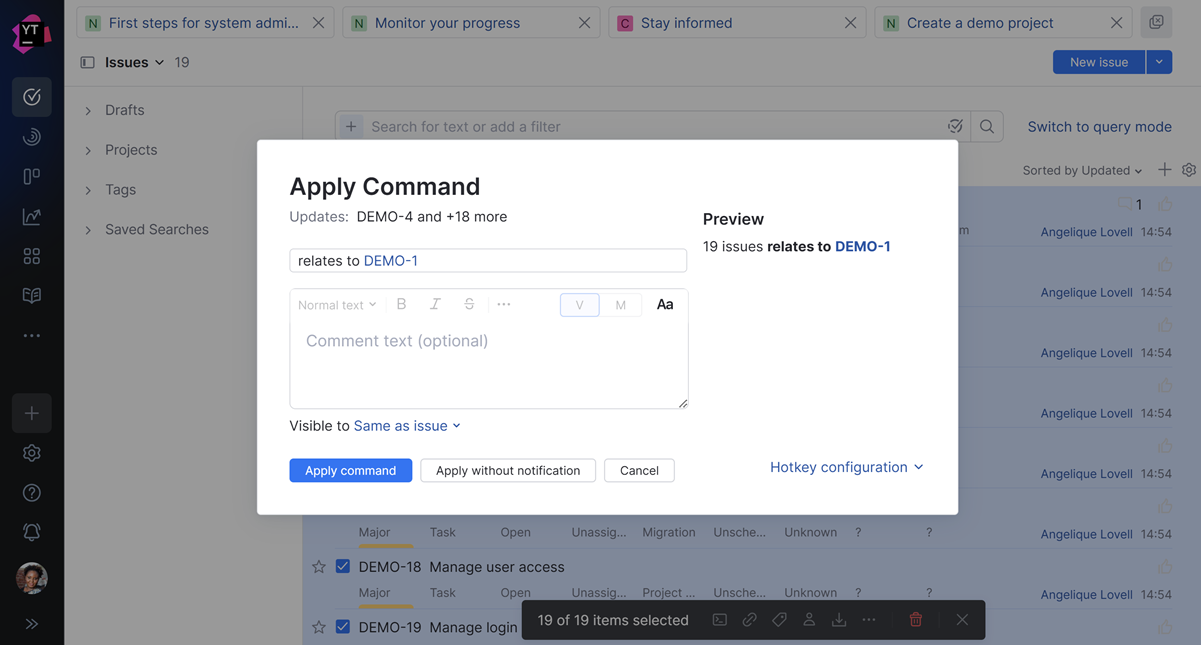 This is a powerful tool that streamlines repetitive tasks and ensures consistent updates. To learn more about this feature, see Apply Commands to Issues. |
Hiding resolved issues | The Classic UI had an option that let you hide resolved items in search results with a single click. This update makes this functionality available to all users.  To learn more about this feature, see Resolved Issue Filter. |
Issue data export | Allowing everyone to select multiple issues in the list gave us the ability to let you export data for selected issues as well.  To learn more about this feature, see Export Issue Data. |
Release notes | The ability to generate release notes for issues that match a search query is universally available.  To learn more about this feature, see Generate Release Notes. |
Discontinued Features
As part of this redesign, we streamlined the interface to provide a more cohesive and efficient experience. To achieve this, we had to remove some less commonly used functionality that didn’t align with the updated flow. This includes the following:
Feature | Description |
|---|---|
Generating reports directly from the list of issues | In the previous versions of YouTrack, there was an option to create a report directly from the list of issues using the current search criteria as the filter. Statistical usage data showed that it was rarely used, likely because it didn’t offer a meaningful time-saving advantage. 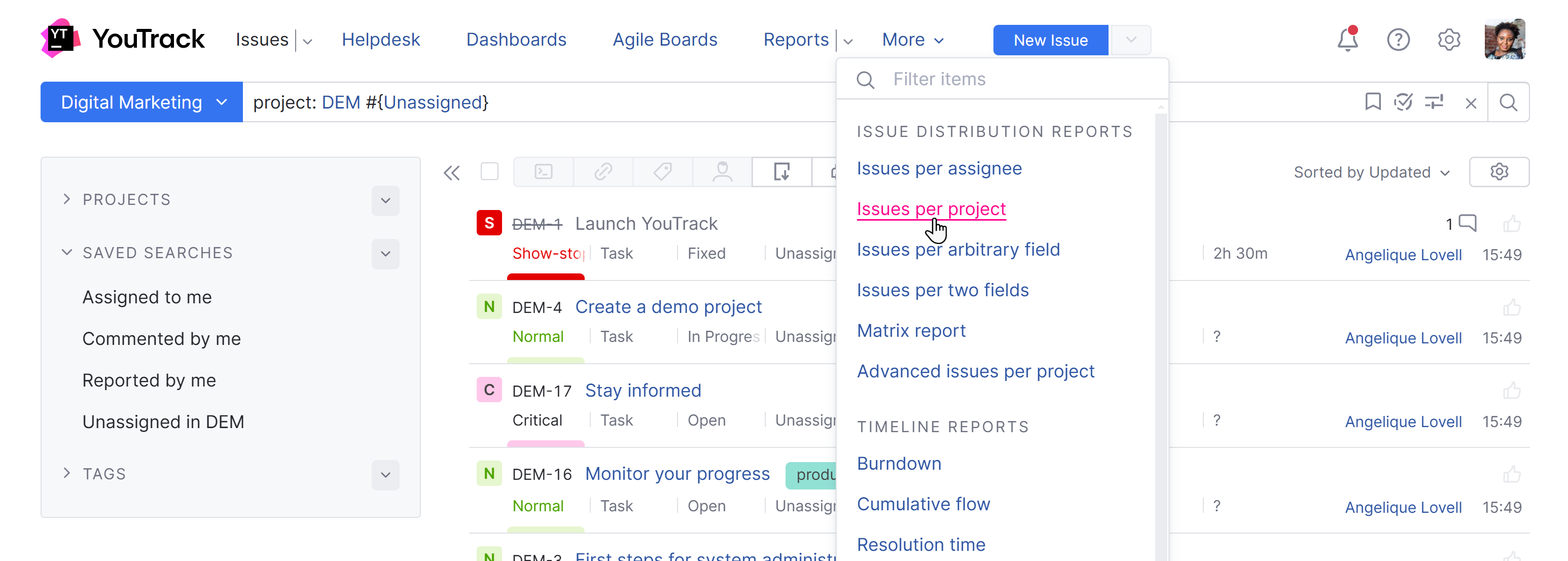 Users who relied on this option will need to copy their search queries manually when creating new reports. |
Issue summaries in hyperlinks | In an earlier version of YouTrack, we replaced references to issue IDs in issue descriptions and comments with the issue summary.  This feature was met with mixed reactions, which prompted us to revert this change for users working with YouTrack Classic. To maintain consistency across the application, we decided to revert this change for everyone. References to issue IDs that are transformed into links now use the issue ID as the link text. The issue summary and current values for key custom fields are shown as a tooltip.  Links to articles in the knowledge base continue to use the article title as the link text. |
Predefined filters | The static filters supported in YouTrack Classic and YouTrack Lite have been replaced with dynamic filters that you can access directly in the search input.  Even though you can no longer configure and work with a predefined set of filters, available filters are suggested automatically as you type. This means you can find exactly what you're looking for with fewer clicks. To learn more about the new dynamic filters, see Simple Search. |
Modal popup for issue previews | YouTrack Classic supported two modes for previewing issues in the list: an inline preview to expand single issues and a modal popup. Now that we introduced the option to switch between inline previews and the sidebar preview panel, we've removed the modal popup. 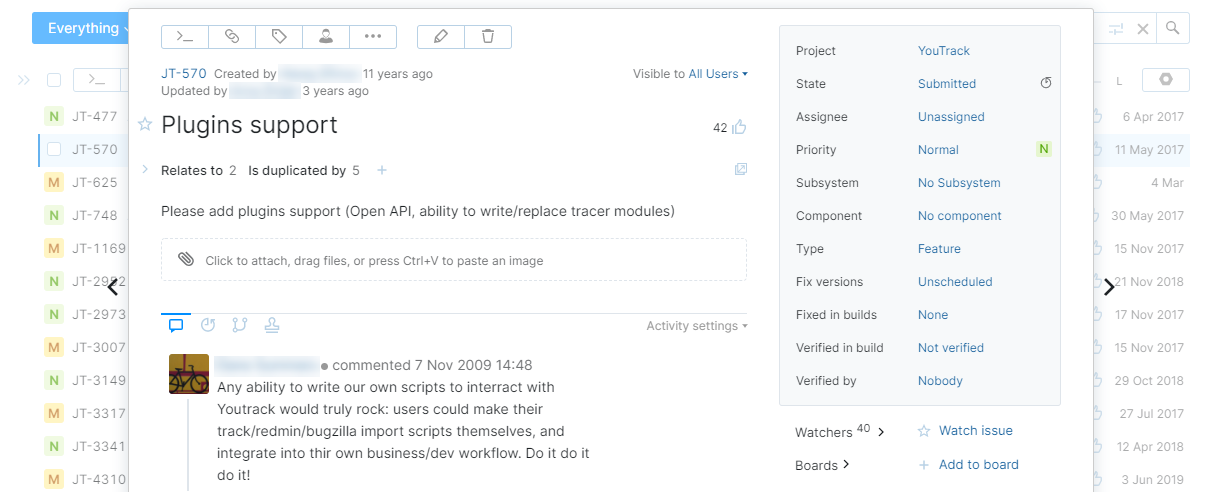 If you were comfortable with the modal preview, we suggest switching to the Sidebar option. |
Frequently Asked Questions
We recognize that change can be confusing, so we compiled a list of frequently asked questions to address the most common inquiries and help you navigate the updated interface.
The vertical navigation panel maximizes screen space, provides quick access to features, and can be collapsed to reduce visual clutter, making it easier to focus on your work.
- Why did you get rid of YouTrack Classic and YouTrack Lite?
The unified issue views combine the best aspects of both YouTrack Classic and YouTrack Lite, creating a single, consistent interface with greater flexibility and functionality while preserving key features used by all users.
- Where can I find the issue toolbar?
The issue selection toolbar appears when you select one or more issues from the list. It provides quick actions like adding links, files, or tags and supports batch updates.
- How do I adjust the display of the issue list?
Use the Settings panel to toggle between the table and list layouts. You can also adjust the scale to manage the level of detail displayed in the list and choose which style you prefer for previewing single issues.
- Where can I find the option to copy the issue ID and summary?
The control that lets you copy the issue ID and summary has moved to the right of the issue ID, which is now part of the breadcrumb navigation in the header.
- How do I change the search context?
The search context feature is still available but has been updated. You can now select a project, saved search, or tag from the sidebar, and the selected context is reflected in the breadcrumb navigation. The selection menu in the breadcrumb navigation lets you quickly switch between different search contexts.
- How can I manually reorder issues in the list?
You can sort issues manually by dragging an issue by the handle to the left of the list and dropping it in the desired location. This feature is only available when working with a search context.
- How do I generate release notes?
The option to generate release notes was removed from the Reports menu. This action is now available from the Options menu for each saved search in the sidebar.
- What happened to the modal popup for issue previews?
The option to show issue previews in a modal popup has been removed. Users who were comfortable with this view can get a similar experience by switching their preview mode to the Sidebar.
Most navigation-related controls were moved to the application header. To maintain a consistent experience with other pages, we moved the controls for navigating between reports to the selection menu in the header as well. Here, you will find all the reports that you have created yourself or have been shared by other members of your team with your favorites at the top of the list.